Written by: Lucas Tcheyan, Research Assistant at Galaxy Digital.
Translated by: Golden Finance xiaozou
Since July 16, ETH unstaking requests have surged sharply, with validator exit requests skyrocketing from 1,920 to over 475,000 by July 22, and wait times extending from less than an hour to over eight days. Although ETH's recent price performance has been excellent and the ETH Pectra upgrade has adjusted the staking requirements for validators, an increase in unstaking activity is expected; however, this surge is primarily driven by the spike in ETH lending rates that began on July 16. The rise in rates triggered widespread liquidations of ETH circular strategies, exacerbating the decoupling pressure on ETH-based liquid staking and re-staking tokens (LSTs and LRTs).
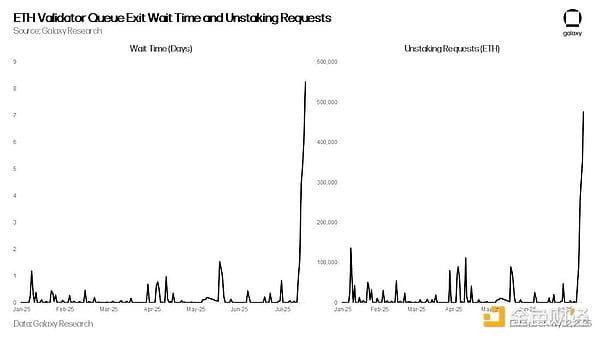
1. Ethereum Staking Queue
Ethereum's unstaking exit queue is a built-in mechanism designed to manage validators' orderly withdrawal of staked funds from the network. To maintain network stability and prevent large-scale validator exits from jeopardizing consensus, Ethereum limits the number of validators that can exit during each epoch. This limit, known as the 'churn limit,' is related to the total number of active validators, allowing approximately 8 to 10 validators to exit each epoch (about 6.4 minutes). When a validator initiates a voluntary exit, they enter the queue and wait for processing. After exiting, the funds must undergo a mandatory delay (approximately 27 hours) before they can be withdrawn. During periods of high withdrawal demand, the queue may become severely backlogged, resulting in wait times of several days or even weeks.
This is not the first time Ethereum has experienced an unstaking backlog. In January 2024, due to the bankrupt crypto lending platform Celsius needing to withdraw 550,000 ETH during its restructuring process, the wait time reached six days.
2. ETH Circular Strategy Liquidation Wave: Rising Lending Rates Trigger Chain Reactions
Since July 14, the ETH lending rate in the Aave decentralized finance protocol has begun to soar periodically. While the lending rate typically remains in the 2% to 3% range, it soared to a high of 18% on July 16, 18, and 21. This sharp fluctuation was caused by large-scale withdrawals from wallets associated with the HTX exchange, leading to a drastic reduction in ETH supply on the Aave platform. Since June 18, this wallet has withdrawn over 167,000 ETH in total, and the sudden decrease in available deposits has put pressure on users operating ETH circular strategies on Aave, which is also part of the reason for the surge in un-staking requests.
Circular strategies are leverage amplification strategies for ETH staking widely adopted by crypto traders. The standard operating procedure is as follows: users deposit liquid staking tokens (LST) or liquid re-staking tokens (LRT) as collateral into platforms like Aave, borrow ETH, and then exchange it for more LST to re-deposit, establishing leveraged positions through repeated operations. When staking yields exceed ETH lending rates, users can profit from the interest rate spread. This strategy can be operated manually or executed through automated vaults provided by protocols such as EtherFi and Instadapp.
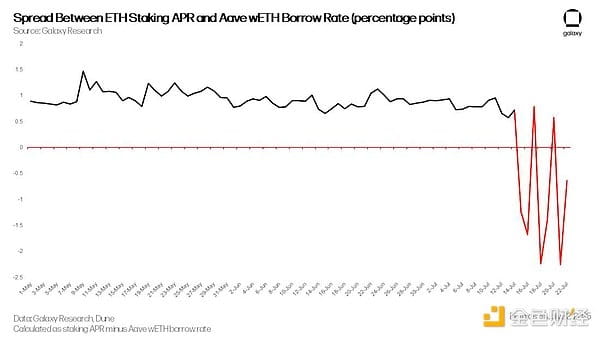
However, with the ETH supply tightening starting July 16, the staking yield and lending rates are affected.
The interest rate spread between borrowing costs turned negative. As of July 21, the spread dropped to a low of -2.25%, rendering circular strategies unprofitable. This triggered a massive wave of liquidations, with users starting to withdraw their deposited ETH, repay loans, and gradually reduce leverage. Since most traders use LST/LRT as collateral, they need to exchange these assets back to ETH or unstake them, putting additional pressure on the LST/LRT secondary market and the Ethereum validator exit queue.
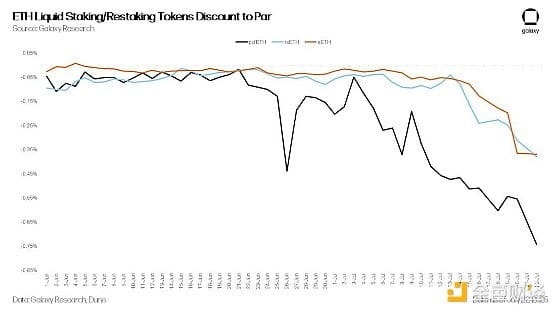
As lending rates rise, the decoupling phenomenon of LST and LRT from ETH intensifies. Generally, LST/LRT maintains a slight discount relative to ETH to compensate for redemption delays caused by Ethereum's exit queue, DEX liquidity constraints, and protocol-specific risks (such as penalties or smart contract risks). During forced deleveraging or redemption periods, this selling pressure drives LST/LRT prices further below par. Moreover, automated circular strategy vaults respond differently to market volatility—some choose to unstake, while others directly sell in the secondary market. For instance, as of now, EtherFi's liquidity strategy still has about 20,000 ETH in the Ethereum exit queue.
Another factor exacerbating queue congestion is that some market participants have begun to arbitrage the decoupling phenomenon of LST/LRT. By purchasing LST/LRT at a discount in the secondary market and then redeeming them for the full ETH value through unstaking, they can profit from the price difference. This behavior further increases the number of ETH exit requests in the queue.
3. A new surge in staking demand synchronously increases.
Counterbalancing the surge in un-staking requests is the significant warming of new staking demand. Since June, ETH staking applications and validator admission requests have climbed to their highest level since April 2024.
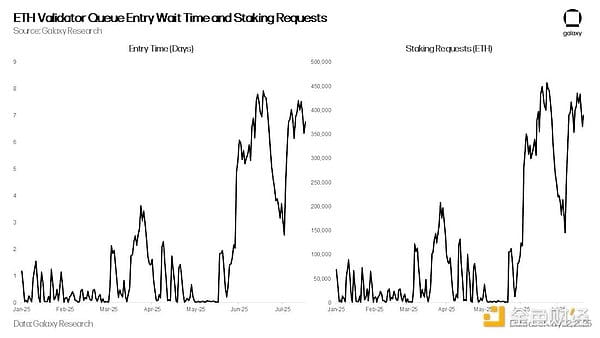
This primarily stems from two driving factors: first, the superior nature of ETH assets compared to Bitcoin.
The unusual performance reignites market enthusiasm; furthermore, several digital asset treasury companies (DATCOs) have recently purchased over $2.5 billion worth of ETH.
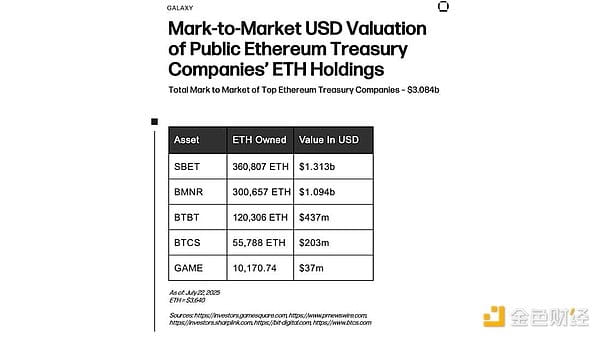
4. Outlook
Although the headlines regarding the unstaking of ETH may initially suggest a wave of profit-taking, a closer observation reveals that much of the activity is actually driven by the turmoil in the ETH lending market and the surge in lending rates that began on July 16. This view is supported by the still-strong new staking demand—new staking volumes have nearly offset the current withdrawal scale.
Despite the surge in demand, the ETH staking structure continues to operate as expected. While some may complain about the significant extension of wait times, this is precisely a design feature of the network rather than a flaw. Its purpose is to limit the rate at which validators can enter or exit, thereby protecting the stability and security of Ethereum's Proof of Stake (PoS) consensus mechanism.
However, this incident highlights the ongoing vulnerability of the ETH liquid staking and re-staking ecosystem. These assets remain highly sensitive to leverage strategies and are prone to pressure under extreme market conditions. The widespread impact of LST/LRT decoupling and redemption delays further underscores the importance of considering duration risk and liquidity bottlenecks.
Looking ahead, protocols that rely entirely on Ethereum's native exit mechanism may face more stringent scrutiny. We anticipate that the market will increasingly focus on solutions that enhance redemption flexibility—such as peer-to-peer exit markets, optimized LST/LRT automated market makers (AMMs), and protocol-native liquidity vaults specifically designed to mitigate exit queue congestion and smooth capital flows.



